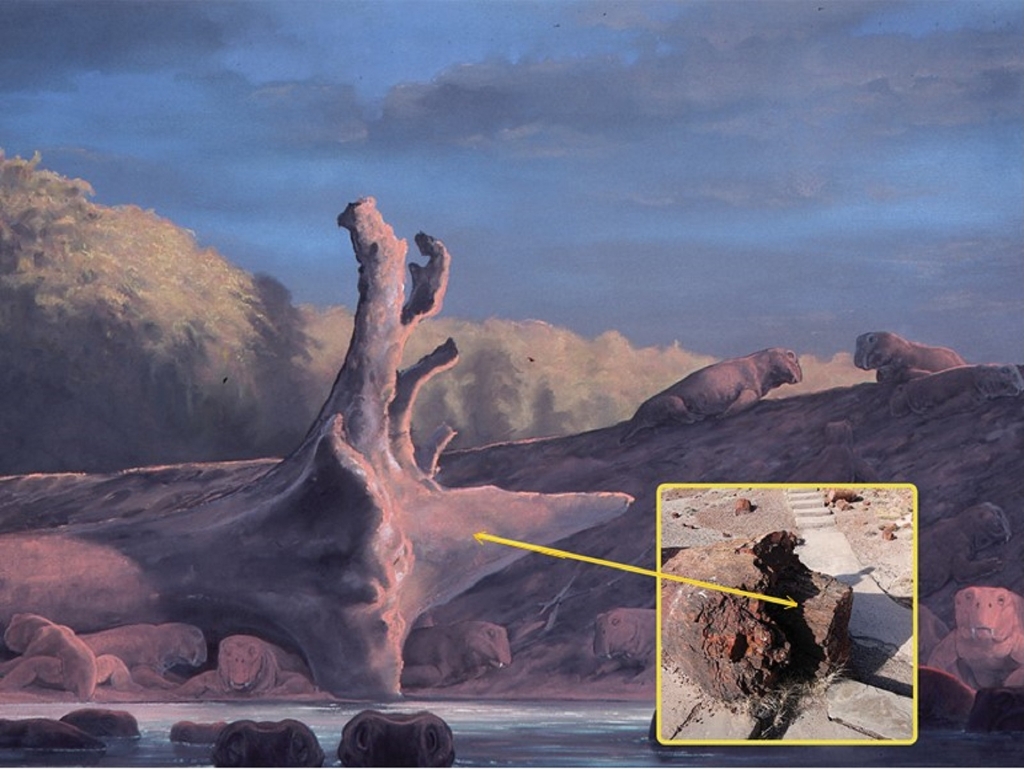
Stop 9: Tap into the Past
Note: image isn't working properly right now!
As you round the bend, take a look at the massive log next to the trail. Roots and branches fall away from rotting trees, but this one still shows the stump of its taproot. A taproot is a central, dominant, deep-anchoring root.
A tree is more than its trunk. Fossilized cones, needles, and roots tell us as much about the ancient trees as the fossilized logs do. Fossilized cones tell us the trees were conifers, reproducing through seed-bearing cones, like a modern pine tree. The taproot itself is also like some modern pines. Its purpose is to stabilize and nourish the tree during severe storms and drought.
Nearly a dozen types of petrified wood have been formally described. There are more species that have yet to be determined. A healthy ecosystem is a diverse one.
It was a time before flowers. Coniferous trees, tree ferns, and gingkoes thrived in the ancient subtropical landscape. Many of the giant logs found along the trail, unique to this area, have been given the scientific name Araucarioxylon arizonicum.
Note: image isn't working properly right now!
As you round the bend, take a look at the massive log next to the trail. Roots and branches fall away from rotting trees, but this one still shows the stump of its taproot. A taproot is a central, dominant, deep-anchoring root.
A tree is more than its trunk. Fossilized cones, needles, and roots tell us as much about the ancient trees as the fossilized logs do. Fossilized cones tell us the trees were conifers, reproducing through seed-bearing cones, like a modern pine tree. The taproot itself is also like some modern pines. Its purpose is to stabilize and nourish the tree during severe storms and drought.
Nearly a dozen types of petrified wood have been formally described. There are more species that have yet to be determined. A healthy ecosystem is a diverse one.
It was a time before flowers. Coniferous trees, tree ferns, and gingkoes thrived in the ancient subtropical landscape. Many of the giant logs found along the trail, unique to this area, have been given the scientific name Araucarioxylon arizonicum.
Is there something we missed for this itinerary?
Itineraries across USA

Acadia

Arches National Park

Badlands

Big Bend

Biscayne

Black Canyon Of The Gunnison

Bryce Canyon

Canyonlands

Capitol Reef

Carlsbad Caverns

Channel Islands

Congaree

Crater Lake

Cuyahoga Valley

Death Valley

Dry Tortugas

Everglades

Gateway Arch

Glacier

Grand Canyon

Grand Teton

Great Basin

Great Smoky Mountains

Guadalupe Mountains

Haleakalā

Hawaiʻi Volcanoes

Hot Springs

Indiana Dunes

Isle Royale

Joshua Tree

Kenai Fjords

Kobuk Valley

Lassen Volcanic

Mammoth Cave

Mesa Verde

Mount Rainier

North Cascades

Olympic

Petrified Forest

Pinnacles

Rocky Mountain

Saguaro

Shenandoah

Theodore Roosevelt

Virgin Islands

Voyageurs

White Sands

Wind Cave

Yellowstone

Yosemite

Zion